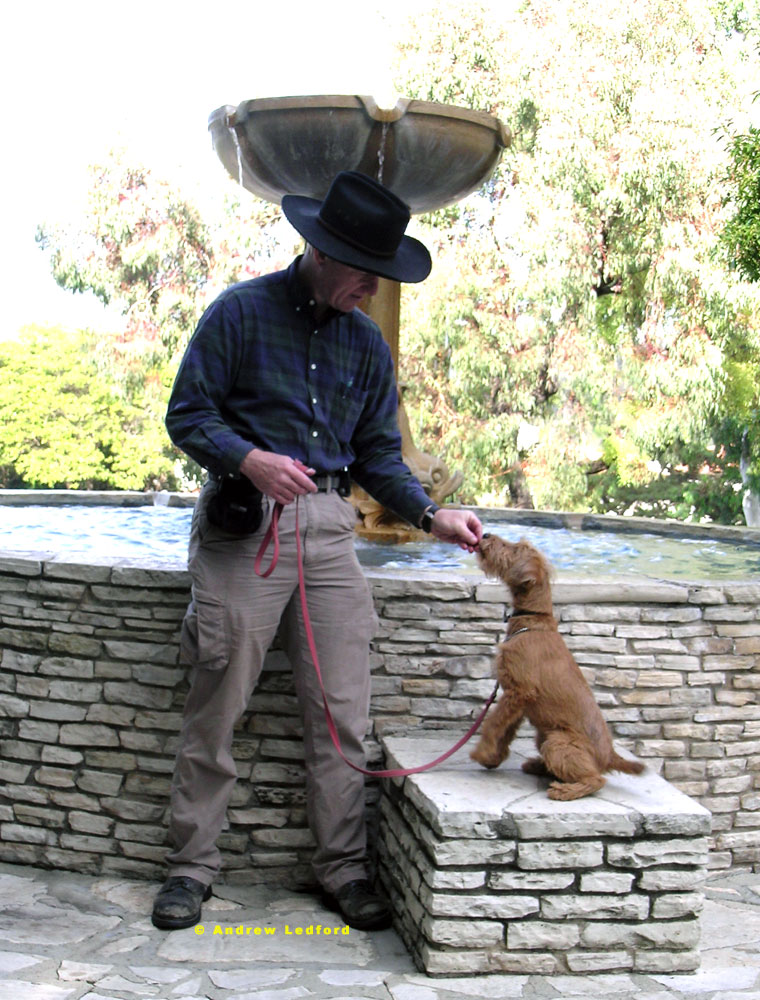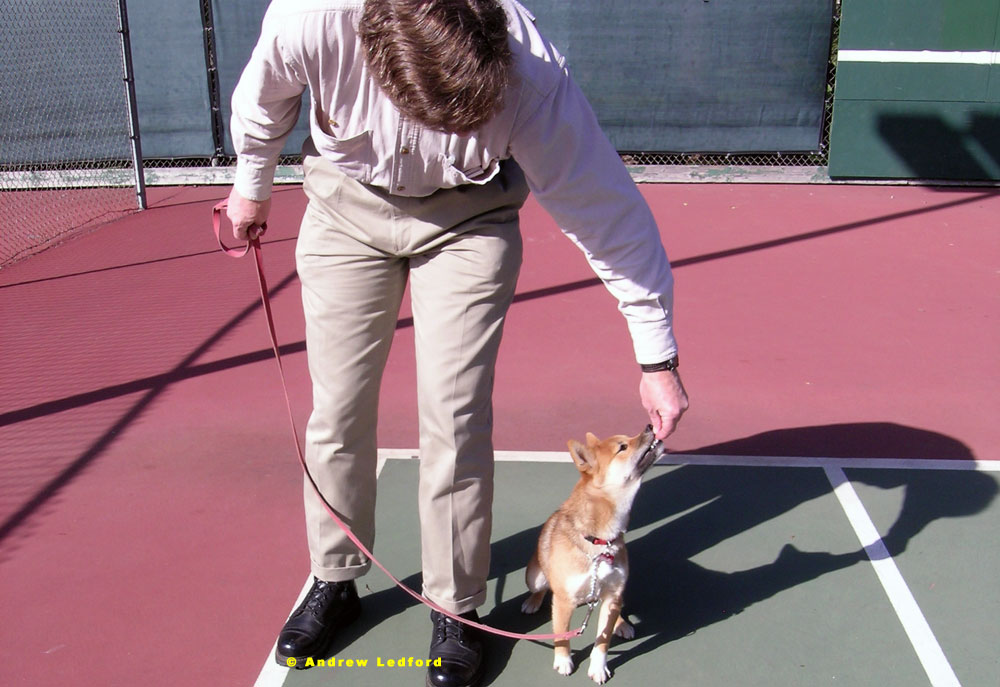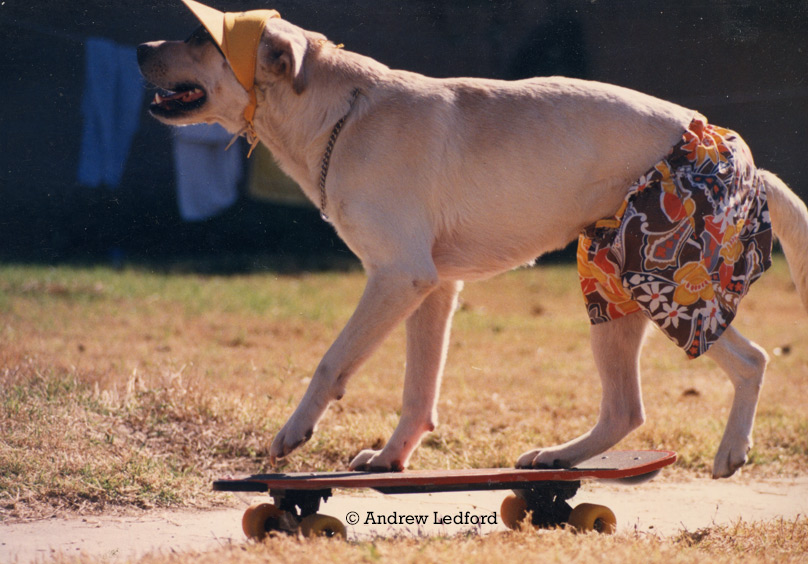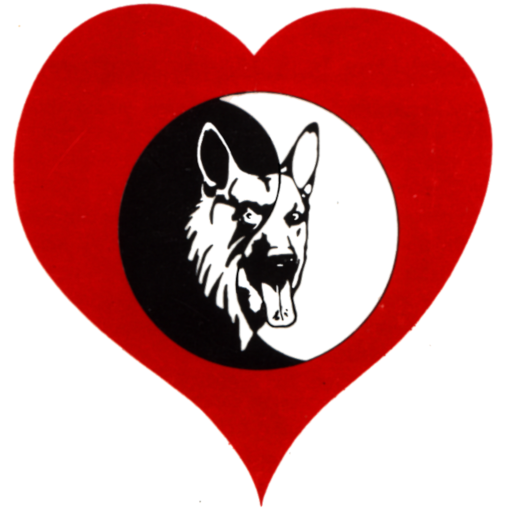Reward Training and Positive Reinforcement
Reward Training and Positive Reinforcement Dog Training By Andrew Ledford 714-827-4058
Reward dog training tips
- Use rewards as a lure
- Use rewards to strengthen behavior
- Reward the dog’s best response

Many people think that reward training is the modern method of dog training. It’s my belief that reward training predates leash training. It is reasonable to believe that reward training was fairly well developed by early humans. This would be especially true for the priests of people who kept animals as a form of worship.
In my library I have a book from the 1930s that describes many modern reward training principles. The time period roughly corresponds to when B.F. Skinner received his PhD and before much of the scientific research about operant conditioning was published. This shows that people who live and work with animals (especially dogs), often have a better feel for the real world than the institutionalized authorities. As I have been known to say, “if you know about dogs, you know about life.”
When considering the historic significance of reward styles of training, it’s important to remember that the scientific study and application of these systems is only about half as old as leash training.

It has only been within the last 25 years that reward training has come into vogue. One thing I’ve noticed about many of the trainers who practice a reward style of training is that they often talk quite poorly about trainers who use a leash style of training. When I see this verbal aggression, I always think they are not as skilled at practicing reinforcement as they are at preaching it.
People who only do reward training believe that part of the answer to dog behavior, is the only answer. On the other side are leash trainers who say reward training will not work unless you always carry rewards with you. These trainers sometimes talk poorly about reward training. They simply don’t know enough about reward training and/or just don’t believe in it. However, they’re not hypocritical in their views when they say bad things about reward training, in that their training system is a more confrontational style.
Clicker training has become all the rage in recent years. Again, in my library I found a book describing this fashionable training fad in the very early 1960s. Clicker training is very effective, especially for people with poor verbal discipline.
I have used a clicker in training since the early to mid 80s. I first introduced a reward style of training into my programs in the late 70s.
At that time, most of the dog trainers I knew said that reward training would not work and not to use it. When I worked for these people I just quit telling them how I trained, and they would be surprised at the results that I achieved.
Usually reward training will incorporate food rewards or a reward that is in some way associated with getting food (this could be a toy). Reward training is the only way you can train some complex types of behavior.

I think it would have been much more difficult to teach my dog to ride his skateboard had I only used the leash and collar. For this type of training, rewards were the most effective approach. Reward training is also the most effective way to teach many types of police and military skills, such as scent detection, tracking, and criminal apprehension.
Reward training can be effective in teaching obedience commands. Basically we can think of all behaviors we bring under command control, simply as units of behavior. If we look at training from this point of view, we can see that teaching a trick is the same as teaching an obedience command.
In reward training a lure is often used to get the dog into the desired position. The purpose of the lure is to get the dog to perform a desired behavior of the dog’s own volition, without any physical manipulation from the handler.
Clicker training usually takes a slightly different approach in that behavior is shaped. Shaping is done by rewarding gradual approximations of the desired behavior and the judicial use of extinction.
Getting the dog to perform a behavior without touching the dog makes a lot of sense, especially when we consider that a dog’s initial reaction to touch is defensive. In general, touch masks all other stimuli. This would mean in theory that if you touch the dog it will be paying more attention to the touch than to anything else, such as the command you are using (discriminating stimuli).
Once the dog has performed the desired behavior, it is rewarded or reinforced. Most reward training styles also incorporate a conditioned reward of some type. Probably the most common is a word such as “GOOD” and the now famous clicker.
To get past the complaint of the staunch leash trainers,” no reward, no behavior,” we need to incorporate scheduling into our reward training programs, as well as the conditioned rewards.
To make a reward trained dog reliable involves the same thing as making a leash trained dog reliable. One of the secrets to making a dog reliable is working the dog around distractions and proper socialization.
Too many times reward trained dogs are only trained inside the house or back yard when only the handler is present. On the side of leash training, we see people working the dog when they take it OUT on walks. To build in reliability, work your dog inside the house, in the yard, on the street, and in the community. It’s advisable to also have friends come to the house to help train your dog. This will give you a chance to train the dog with company.
The other thing that will help make a dog more reliable is to teach the dog to pay attention. “If you have your dog’s attention you’ll have control of the dog.” There are techniques in both reward training and leash training that will encourage the dog to pay attention to the handler.
Call 714-827-4058 today to get more information about my in-home dog training programs.
We provide training services in North Orange County, Long Beach, the 562 area, and the parts of the San Gabriel Valley. I do offer convenient customized In home training to a large portion of Southern California’s most dog friendly communities.
Andrew Ledford
714-827-4058
Previous page Leash Training
